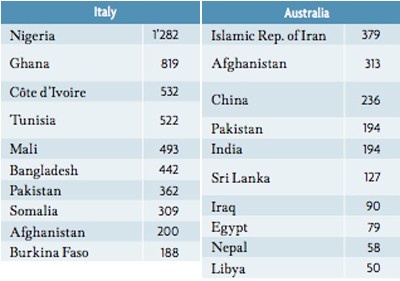The new United Nations High Commission on Refugees figures released yesterday on global asylum claims are a perfect example of how easily the debate over push/pull factors can be obscured.
The figures, for the first six months of 2011, show a global spike in the number of asylum claims lodged in industrialized countries (i.e. a small fraction of actual refugees around the world) compared to the same period in 2010, a rise of 17%. That’s the headline figure that made a lot of the coverage here and overseas — Fairfax, the BBC and Reuters all noted this global rise (although curiously The Australian decided to ignore the issue). It’s hard to blame the media for this, given the UNHCR itself made much of the rise.
But compared to the last six months of 2010, there’s been no rise at all — 0%. That is, 2011 continued exactly as 2010 ended for asylum claims in developed countries. It’s just that numbers increased in the second half of 2010. The somewhat misleading suggestion of a rise in claims also contrasts with the number of claims in Australia, which has fallen significantly from its peak last year.
Chris Bowen’s office was reported in Fairfax as responding rather circumspectly to the contrast. It now, of course, wouldn’t do to draw too much attention to the shelved Malaysian Solution, so that was just one of the factors identified by Bowen’s spokesman, others being outcomes from the Bali regional process and the deterrence effect of the Christmas Island tragedy.
That’s probably a fair assessment, but it excludes the fact that globally, the asylum seeker burden continues to shift away from Australia and its immediate region to Europe, as it has been doing over the last 12 months. There would have been a fall in asylum seeker claims in Australia this year regardless of what the government did.
The shifting regional nature of the global burden is demonstrated by the new figures. The rise in claims between the first half 2010 and 2011, and actual rises since late 2010, have mainly been from African countries. Eritrea, up 60% year on year and 18% since late 2010. Nigeria, up 11% and 12%. Ivory Coast (unsurprisingly) 258% and 262%. Guinea 12% and 11%. Ghana 68% and 103%. On it goes. And there’s no surprise that the Arab Spring prompted a rise in claims from North African and Middle Eastern countries: claims from Tunisians are so far up over 800% this year, Libya is up over 400% second quarter this year, Syria is up 14%, Egypt (off a low base) up 40%.
Needless to say, asylum seekers from those countries mostly end up in Europe. There were big rises in asylum claims from those countries in Europe, and especially in southern Europe, which had 14,000 asylum application in the second quarter of 2011 alone. Of all those countries, only Libya and Egypt appear in Australia’s top ten sources of asylum claims for the second quarter of 2011, and they’re in double figure numbers. Compare the UNHCR’s “top ten” lists for the second quarter of this year for Italy and Australia, which also has a boat arrival problem, in fact one that dwarfs ours in both overall numbers and numbers of fatalities aboard them.

In short, even where there has been an increase in asylum claims around the world, they’ve been from people who almost invariably seek it in Europe. There has been a further increase in claims from Afghans — up 12% this year — and they are more likely to head toward Australia, so they continue to make up one of the biggest sources of asylum seekers here. The murderous régime of Iran, too, can be relied on to drive thousands of its citizens a year to look for sanctuary elsewhere.
But there have been falls globally in asylum claims from the other large sources of asylum seekers: from Iraq, a big fall in claims from Serbia/Kosovo (last year, that was biggest source of asylum claims), Somalia and Russia. These have acted to offset the thousands of additional claimants from Africa, north Africa and the Middle East.
For countries like Australia that accept large numbers of asylum seekers from around the world, the overall global number is irrelevant: there will always be more asylum seekers than resettlement places in western countries. But when it comes to boat arrivals, where asylum seekers are coming from is important. And at the moment, Europe is bearing the burden of increased claims.








Tiny, little Italy! And overpopulated!
I heard that (maybe Italy) had the same number of asylum seekers over a weekend that we’ve had all year? The lies and rot by the Govt and Abbott are just that – lies and rot! Shameful indeed!